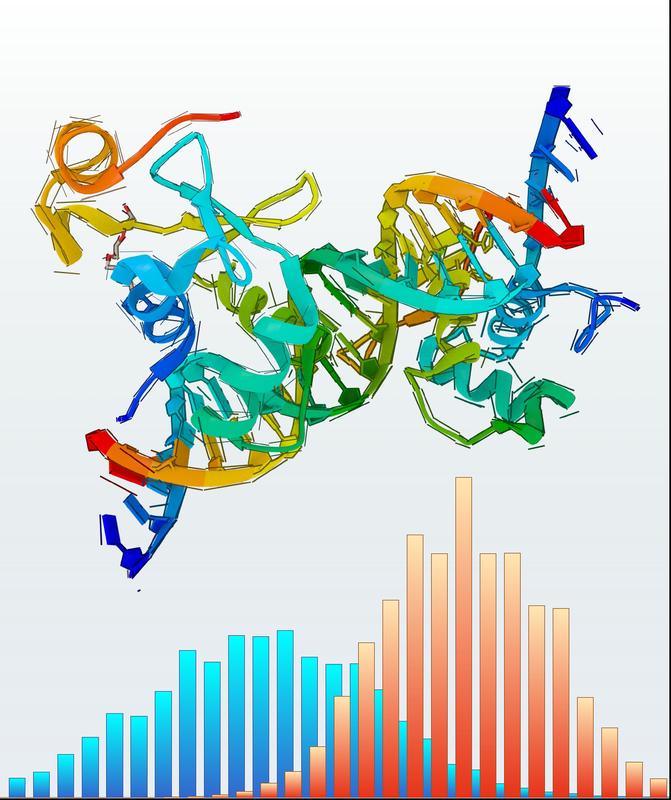Breaking a chemical bond

The illustration schematically depicts a protein structure and rupture force distributions of one of its macromolecular bonds under load for two different loading rates. Graph: Leipzig University, Institute of Theoretical Physics
The fundamental question how a molecular bond breaks is of interest in many fields of science and has been studied extensively. Yet, now writing in Nature Communications, a group of theoretical physicists from the University of Leipzig, Germany, has put forward a more powerful analytical formula for forcible bond breaking than previously available.
It predicts how likely a bond will break at a given load, if probed with a prescribed loading protocol. This so-called rupture force distribution is the most informative and most commonly measured quantity in modern single-molecule force spectroscopy experiments (which may roughly be thought of as nanoscopic versions of the conventional crash- or breaking tests employed in materials science and engineering).
Such experiments are nowadays performed in large numbers in molecular biology and biophysics labs to probe the mechanical strength of individual macromolecular bonds.
Recent methodological advances have pushed force spectroscopy assays to ever higher loading rates (the equivalent of the speed employed in the macroscopic crash-test). This provided a strong incentive for the Leipzig team to improve on current state-of-the-art theories for forcible bond breaking, which are limited to comparatively low speeds.
Moreover, the new equation solves another problem that has bothered experts in the field for many years. Force spectroscopy experiments are often simulated with sophisticated all-atom computer models to supplement the experimental data with information on internal molecular details that cannot be resolved in a laboratory setting.
However, because of their enormous complexity, such computer simulations operate at extremely high loading rates to cut down on the runtime. As a consequence, simulation and experiment were so far two essentially distinct branches of force spectroscopy.
The new equation, which gives exact results for both low and high loading rates, will thus suit both experimentalists and computer scientists, and help them to systematically analyze and compare their results.
This should eventually improve our microscopic understanding of the strength of synthetic materials and of how proteins attain and maintain their three-dimensional structure and perform conformational changes, which are core features determining the function and dysfunction of these amazing engines of life.
Article in „Nature Communications”:
„Theory of rapid force spectroscopy“,
by Jakob T. Bullerjahn, Sebastian Sturm and Klaus Kroy
doi:10.1038/ncomms5463
Contact:
Prof. Dr. Klaus Kroy
Phone: +49 341 97 32436
E-Mail: klaus.kroy@uni-leipzig.de
http://www.nature.com/ncomms/2014/140731/ncomms5463/full/ncomms5463.html
Media Contact
All latest news from the category: Physics and Astronomy
This area deals with the fundamental laws and building blocks of nature and how they interact, the properties and the behavior of matter, and research into space and time and their structures.
innovations-report provides in-depth reports and articles on subjects such as astrophysics, laser technologies, nuclear, quantum, particle and solid-state physics, nanotechnologies, planetary research and findings (Mars, Venus) and developments related to the Hubble Telescope.
Newest articles

Webb captures top of iconic horsehead nebula in unprecedented detail
NASA’s James Webb Space Telescope has captured the sharpest infrared images to date of a zoomed-in portion of one of the most distinctive objects in our skies, the Horsehead Nebula….

Cost-effective, high-capacity, and cyclable lithium-ion battery cathodes
Charge-recharge cycling of lithium-superrich iron oxide, a cost-effective and high-capacity cathode for new-generation lithium-ion batteries, can be greatly improved by doping with readily available mineral elements. The energy capacity and…

Novel genetic plant regeneration approach
…without the application of phytohormones. Researchers develop a novel plant regeneration approach by modulating the expression of genes that control plant cell differentiation. For ages now, plants have been the…





















